International Marketing Plan: Nestle's Kit Kat Launch in Japan
VerifiedAdded on 2020/03/04
|10
|3002
|52
Report
AI Summary
This report provides a detailed analysis of Nestle's international marketing plan, focusing on the company's potential expansion into the Japanese market with its popular Kit Kat chocolate bar. It explores Nestle's background, including its history, organizational resources, strengths, and weaknesses. The report delves into the microenvironment of the Japanese market, considering political, economic, social, technological, legal, and environmental factors. It also examines the competitive landscape, identifying Mars as a key competitor with its Snickers bar. The report concludes that while the Japanese market presents significant opportunities for Nestle, the company must adapt its strategies and products to meet local regulations, consumer preferences, and competitive pressures to achieve success. Desklib offers this report as a solved assignment example for students.
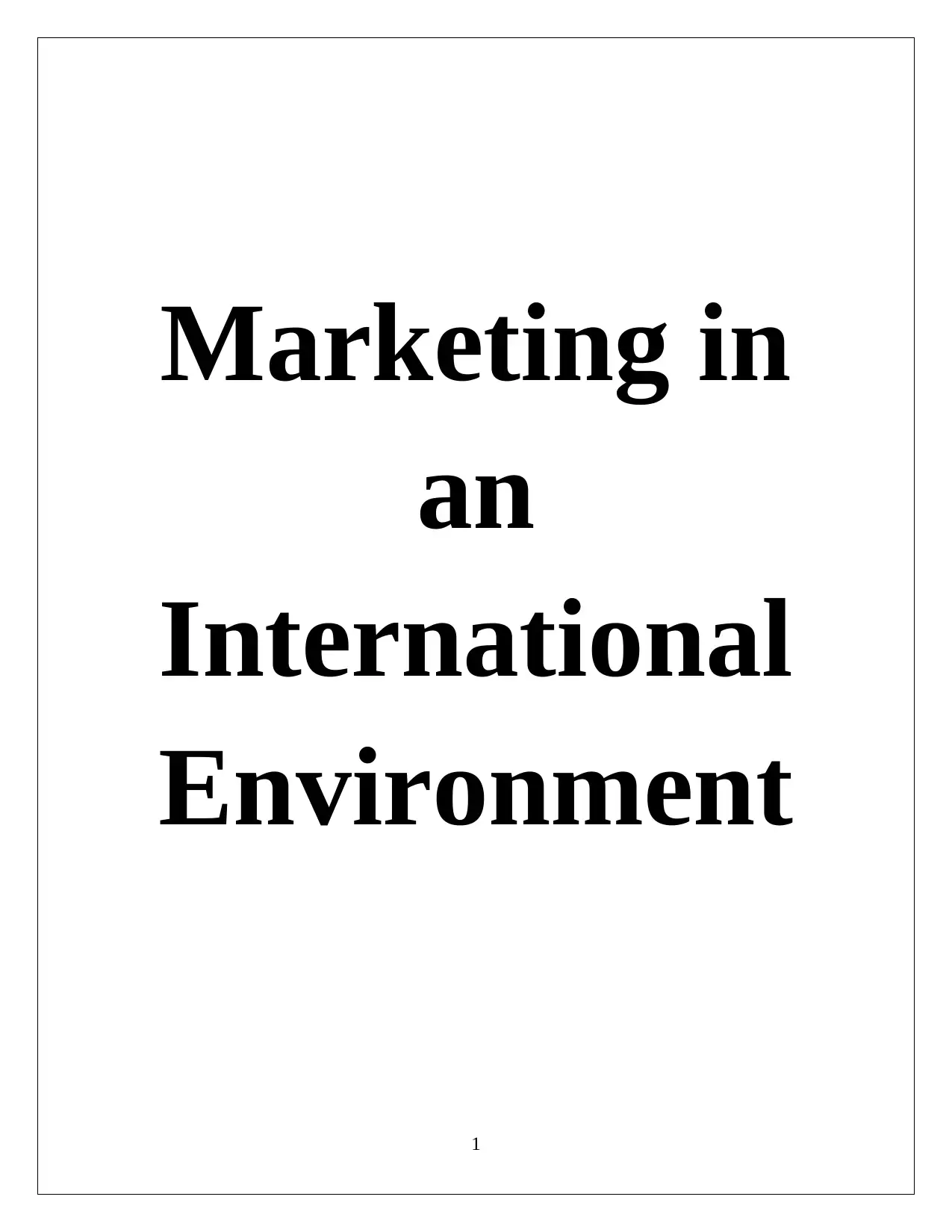
Marketing in
an
International
Environment
1
an
International
Environment
1
Paraphrase This Document
Need a fresh take? Get an instant paraphrase of this document with our AI Paraphraser
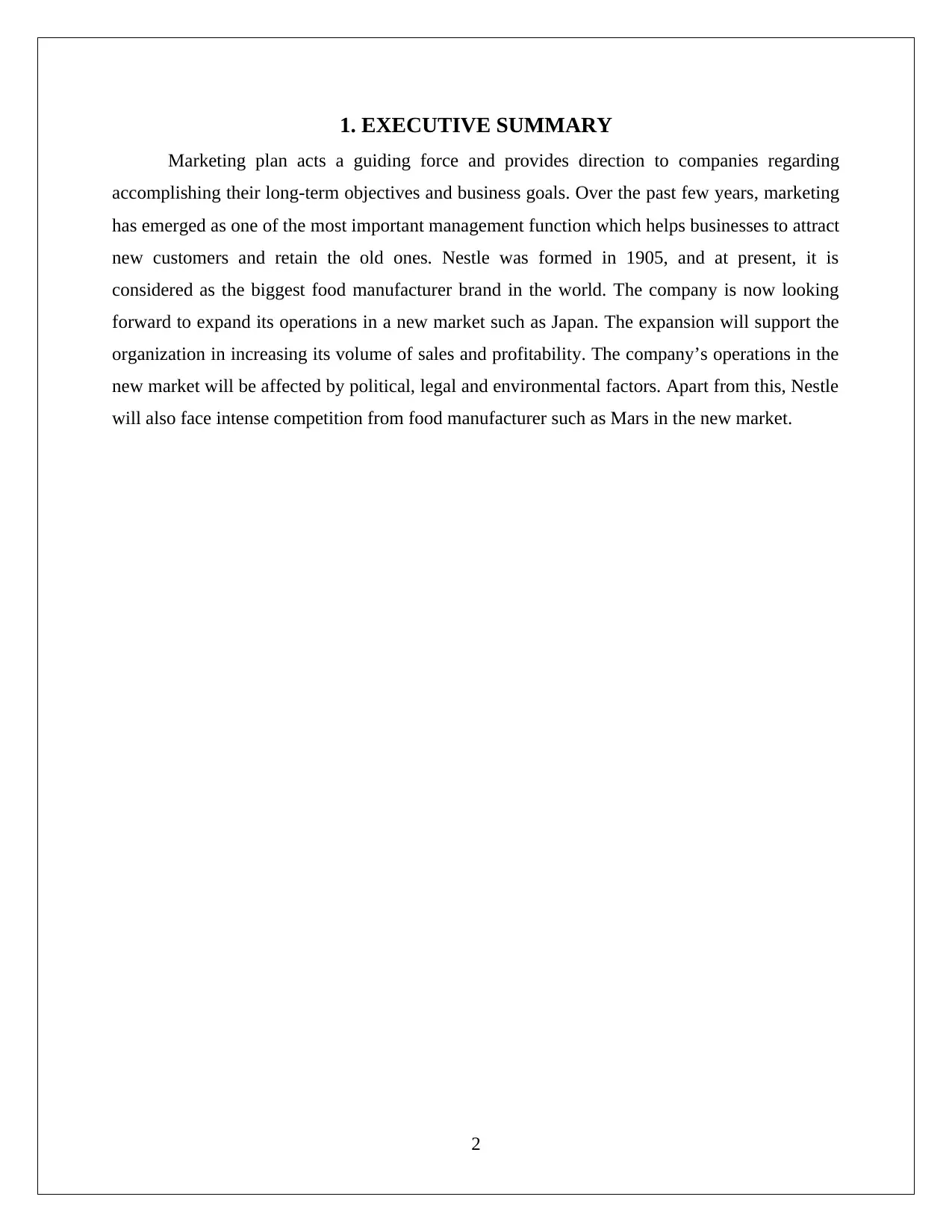
1. EXECUTIVE SUMMARY
Marketing plan acts a guiding force and provides direction to companies regarding
accomplishing their long-term objectives and business goals. Over the past few years, marketing
has emerged as one of the most important management function which helps businesses to attract
new customers and retain the old ones. Nestle was formed in 1905, and at present, it is
considered as the biggest food manufacturer brand in the world. The company is now looking
forward to expand its operations in a new market such as Japan. The expansion will support the
organization in increasing its volume of sales and profitability. The company’s operations in the
new market will be affected by political, legal and environmental factors. Apart from this, Nestle
will also face intense competition from food manufacturer such as Mars in the new market.
2
Marketing plan acts a guiding force and provides direction to companies regarding
accomplishing their long-term objectives and business goals. Over the past few years, marketing
has emerged as one of the most important management function which helps businesses to attract
new customers and retain the old ones. Nestle was formed in 1905, and at present, it is
considered as the biggest food manufacturer brand in the world. The company is now looking
forward to expand its operations in a new market such as Japan. The expansion will support the
organization in increasing its volume of sales and profitability. The company’s operations in the
new market will be affected by political, legal and environmental factors. Apart from this, Nestle
will also face intense competition from food manufacturer such as Mars in the new market.
2
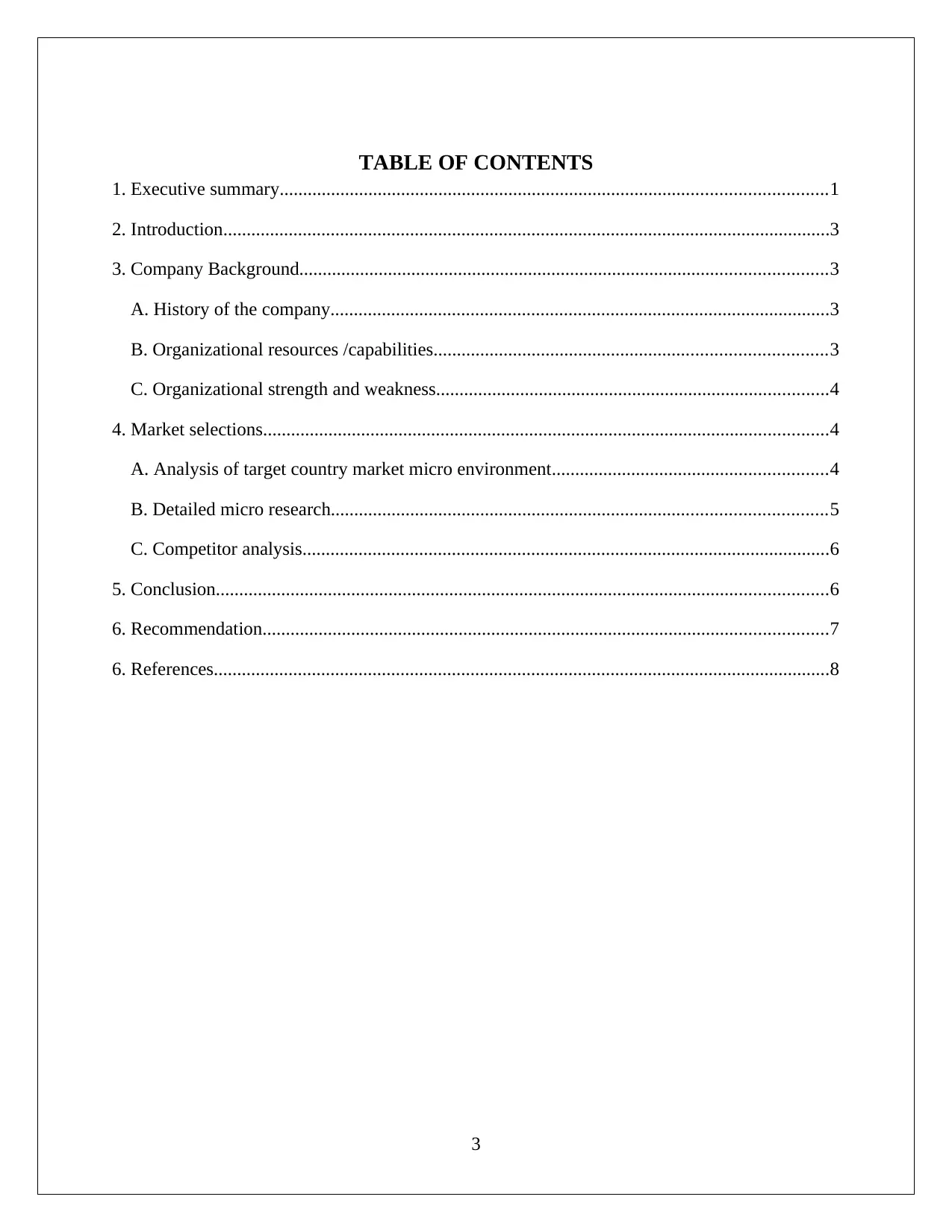
TABLE OF CONTENTS
1. Executive summary.....................................................................................................................1
2. Introduction..................................................................................................................................3
3. Company Background.................................................................................................................3
A. History of the company...........................................................................................................3
B. Organizational resources /capabilities....................................................................................3
C. Organizational strength and weakness....................................................................................4
4. Market selections.........................................................................................................................4
A. Analysis of target country market micro environment...........................................................4
B. Detailed micro research..........................................................................................................5
C. Competitor analysis.................................................................................................................6
5. Conclusion...................................................................................................................................6
6. Recommendation.........................................................................................................................7
6. References....................................................................................................................................8
3
1. Executive summary.....................................................................................................................1
2. Introduction..................................................................................................................................3
3. Company Background.................................................................................................................3
A. History of the company...........................................................................................................3
B. Organizational resources /capabilities....................................................................................3
C. Organizational strength and weakness....................................................................................4
4. Market selections.........................................................................................................................4
A. Analysis of target country market micro environment...........................................................4
B. Detailed micro research..........................................................................................................5
C. Competitor analysis.................................................................................................................6
5. Conclusion...................................................................................................................................6
6. Recommendation.........................................................................................................................7
6. References....................................................................................................................................8
3
⊘ This is a preview!⊘
Do you want full access?
Subscribe today to unlock all pages.

Trusted by 1+ million students worldwide
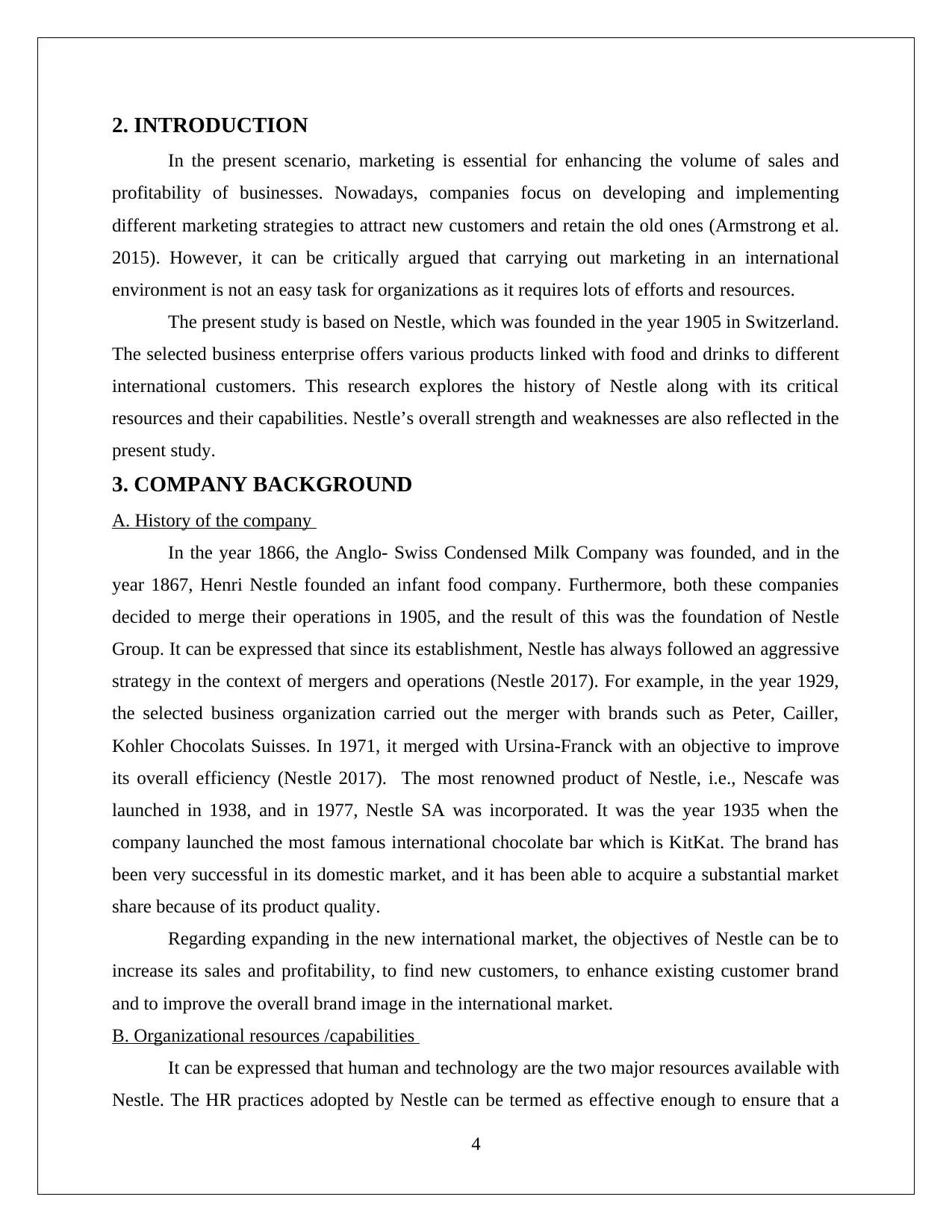
2. INTRODUCTION
In the present scenario, marketing is essential for enhancing the volume of sales and
profitability of businesses. Nowadays, companies focus on developing and implementing
different marketing strategies to attract new customers and retain the old ones (Armstrong et al.
2015). However, it can be critically argued that carrying out marketing in an international
environment is not an easy task for organizations as it requires lots of efforts and resources.
The present study is based on Nestle, which was founded in the year 1905 in Switzerland.
The selected business enterprise offers various products linked with food and drinks to different
international customers. This research explores the history of Nestle along with its critical
resources and their capabilities. Nestle’s overall strength and weaknesses are also reflected in the
present study.
3. COMPANY BACKGROUND
A. History of the company
In the year 1866, the Anglo- Swiss Condensed Milk Company was founded, and in the
year 1867, Henri Nestle founded an infant food company. Furthermore, both these companies
decided to merge their operations in 1905, and the result of this was the foundation of Nestle
Group. It can be expressed that since its establishment, Nestle has always followed an aggressive
strategy in the context of mergers and operations (Nestle 2017). For example, in the year 1929,
the selected business organization carried out the merger with brands such as Peter, Cailler,
Kohler Chocolats Suisses. In 1971, it merged with Ursina-Franck with an objective to improve
its overall efficiency (Nestle 2017). The most renowned product of Nestle, i.e., Nescafe was
launched in 1938, and in 1977, Nestle SA was incorporated. It was the year 1935 when the
company launched the most famous international chocolate bar which is KitKat. The brand has
been very successful in its domestic market, and it has been able to acquire a substantial market
share because of its product quality.
Regarding expanding in the new international market, the objectives of Nestle can be to
increase its sales and profitability, to find new customers, to enhance existing customer brand
and to improve the overall brand image in the international market.
B. Organizational resources /capabilities
It can be expressed that human and technology are the two major resources available with
Nestle. The HR practices adopted by Nestle can be termed as effective enough to ensure that a
4
In the present scenario, marketing is essential for enhancing the volume of sales and
profitability of businesses. Nowadays, companies focus on developing and implementing
different marketing strategies to attract new customers and retain the old ones (Armstrong et al.
2015). However, it can be critically argued that carrying out marketing in an international
environment is not an easy task for organizations as it requires lots of efforts and resources.
The present study is based on Nestle, which was founded in the year 1905 in Switzerland.
The selected business enterprise offers various products linked with food and drinks to different
international customers. This research explores the history of Nestle along with its critical
resources and their capabilities. Nestle’s overall strength and weaknesses are also reflected in the
present study.
3. COMPANY BACKGROUND
A. History of the company
In the year 1866, the Anglo- Swiss Condensed Milk Company was founded, and in the
year 1867, Henri Nestle founded an infant food company. Furthermore, both these companies
decided to merge their operations in 1905, and the result of this was the foundation of Nestle
Group. It can be expressed that since its establishment, Nestle has always followed an aggressive
strategy in the context of mergers and operations (Nestle 2017). For example, in the year 1929,
the selected business organization carried out the merger with brands such as Peter, Cailler,
Kohler Chocolats Suisses. In 1971, it merged with Ursina-Franck with an objective to improve
its overall efficiency (Nestle 2017). The most renowned product of Nestle, i.e., Nescafe was
launched in 1938, and in 1977, Nestle SA was incorporated. It was the year 1935 when the
company launched the most famous international chocolate bar which is KitKat. The brand has
been very successful in its domestic market, and it has been able to acquire a substantial market
share because of its product quality.
Regarding expanding in the new international market, the objectives of Nestle can be to
increase its sales and profitability, to find new customers, to enhance existing customer brand
and to improve the overall brand image in the international market.
B. Organizational resources /capabilities
It can be expressed that human and technology are the two major resources available with
Nestle. The HR practices adopted by Nestle can be termed as effective enough to ensure that a
4
Paraphrase This Document
Need a fresh take? Get an instant paraphrase of this document with our AI Paraphraser
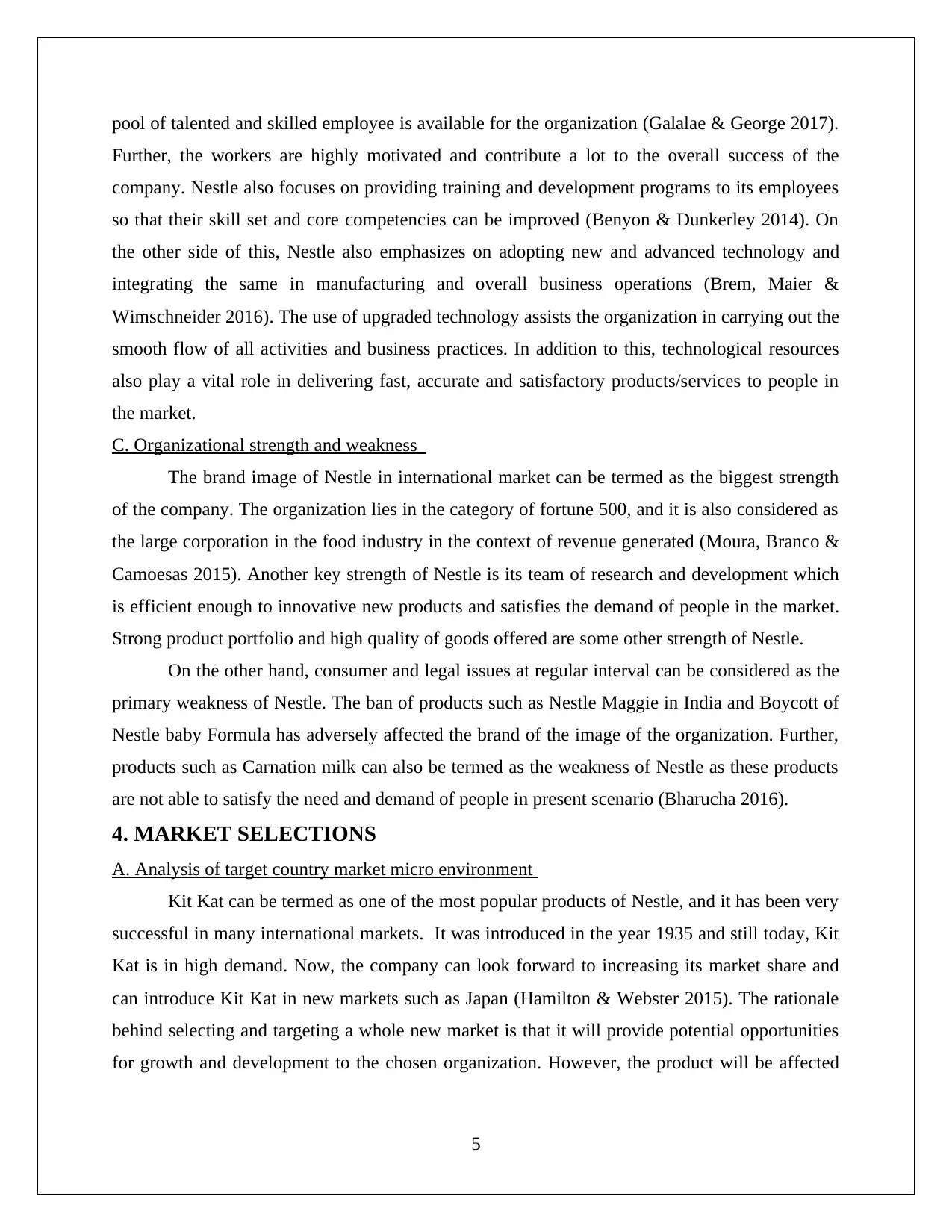
pool of talented and skilled employee is available for the organization (Galalae & George 2017).
Further, the workers are highly motivated and contribute a lot to the overall success of the
company. Nestle also focuses on providing training and development programs to its employees
so that their skill set and core competencies can be improved (Benyon & Dunkerley 2014). On
the other side of this, Nestle also emphasizes on adopting new and advanced technology and
integrating the same in manufacturing and overall business operations (Brem, Maier &
Wimschneider 2016). The use of upgraded technology assists the organization in carrying out the
smooth flow of all activities and business practices. In addition to this, technological resources
also play a vital role in delivering fast, accurate and satisfactory products/services to people in
the market.
C. Organizational strength and weakness
The brand image of Nestle in international market can be termed as the biggest strength
of the company. The organization lies in the category of fortune 500, and it is also considered as
the large corporation in the food industry in the context of revenue generated (Moura, Branco &
Camoesas 2015). Another key strength of Nestle is its team of research and development which
is efficient enough to innovative new products and satisfies the demand of people in the market.
Strong product portfolio and high quality of goods offered are some other strength of Nestle.
On the other hand, consumer and legal issues at regular interval can be considered as the
primary weakness of Nestle. The ban of products such as Nestle Maggie in India and Boycott of
Nestle baby Formula has adversely affected the brand of the image of the organization. Further,
products such as Carnation milk can also be termed as the weakness of Nestle as these products
are not able to satisfy the need and demand of people in present scenario (Bharucha 2016).
4. MARKET SELECTIONS
A. Analysis of target country market micro environment
Kit Kat can be termed as one of the most popular products of Nestle, and it has been very
successful in many international markets. It was introduced in the year 1935 and still today, Kit
Kat is in high demand. Now, the company can look forward to increasing its market share and
can introduce Kit Kat in new markets such as Japan (Hamilton & Webster 2015). The rationale
behind selecting and targeting a whole new market is that it will provide potential opportunities
for growth and development to the chosen organization. However, the product will be affected
5
Further, the workers are highly motivated and contribute a lot to the overall success of the
company. Nestle also focuses on providing training and development programs to its employees
so that their skill set and core competencies can be improved (Benyon & Dunkerley 2014). On
the other side of this, Nestle also emphasizes on adopting new and advanced technology and
integrating the same in manufacturing and overall business operations (Brem, Maier &
Wimschneider 2016). The use of upgraded technology assists the organization in carrying out the
smooth flow of all activities and business practices. In addition to this, technological resources
also play a vital role in delivering fast, accurate and satisfactory products/services to people in
the market.
C. Organizational strength and weakness
The brand image of Nestle in international market can be termed as the biggest strength
of the company. The organization lies in the category of fortune 500, and it is also considered as
the large corporation in the food industry in the context of revenue generated (Moura, Branco &
Camoesas 2015). Another key strength of Nestle is its team of research and development which
is efficient enough to innovative new products and satisfies the demand of people in the market.
Strong product portfolio and high quality of goods offered are some other strength of Nestle.
On the other hand, consumer and legal issues at regular interval can be considered as the
primary weakness of Nestle. The ban of products such as Nestle Maggie in India and Boycott of
Nestle baby Formula has adversely affected the brand of the image of the organization. Further,
products such as Carnation milk can also be termed as the weakness of Nestle as these products
are not able to satisfy the need and demand of people in present scenario (Bharucha 2016).
4. MARKET SELECTIONS
A. Analysis of target country market micro environment
Kit Kat can be termed as one of the most popular products of Nestle, and it has been very
successful in many international markets. It was introduced in the year 1935 and still today, Kit
Kat is in high demand. Now, the company can look forward to increasing its market share and
can introduce Kit Kat in new markets such as Japan (Hamilton & Webster 2015). The rationale
behind selecting and targeting a whole new market is that it will provide potential opportunities
for growth and development to the chosen organization. However, the product will be affected
5
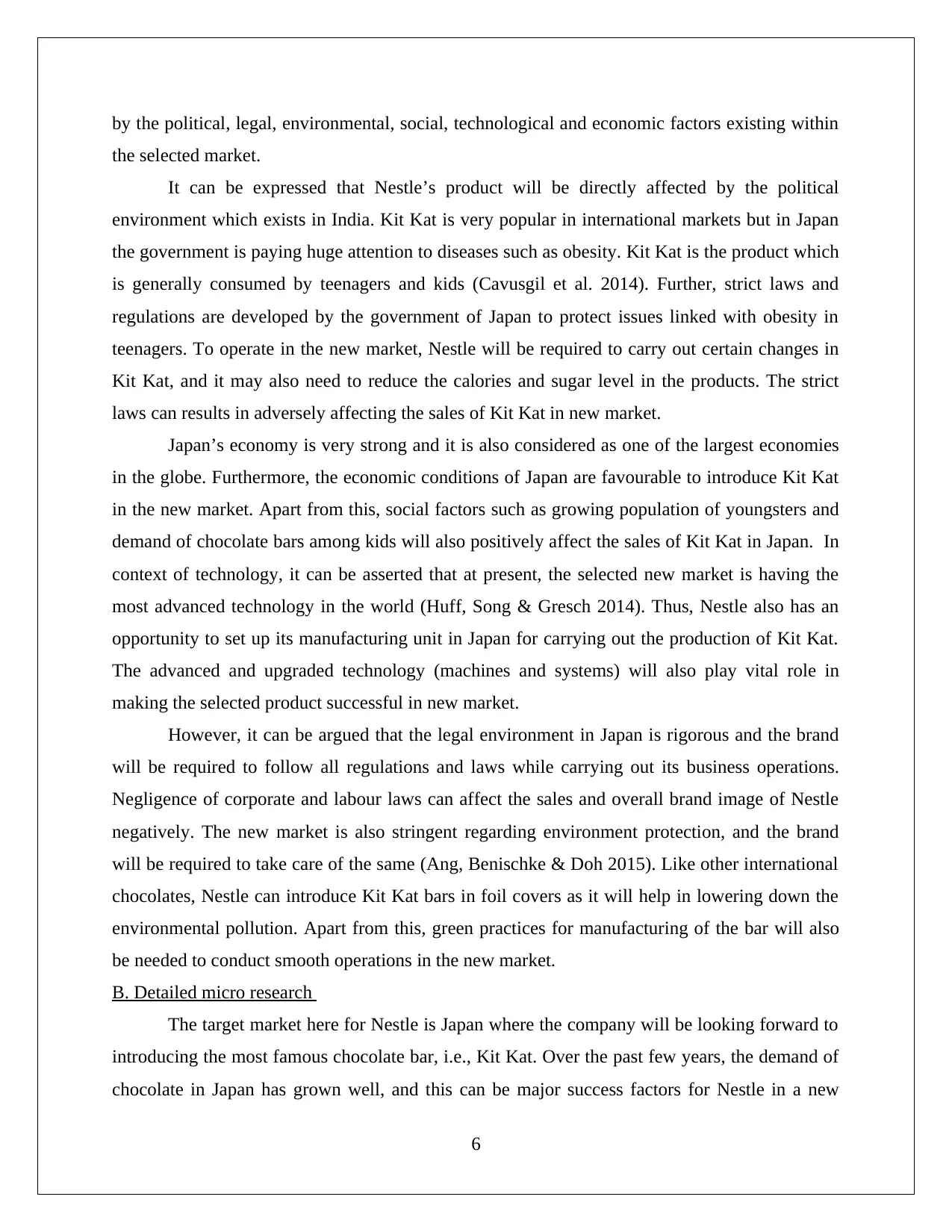
by the political, legal, environmental, social, technological and economic factors existing within
the selected market.
It can be expressed that Nestle’s product will be directly affected by the political
environment which exists in India. Kit Kat is very popular in international markets but in Japan
the government is paying huge attention to diseases such as obesity. Kit Kat is the product which
is generally consumed by teenagers and kids (Cavusgil et al. 2014). Further, strict laws and
regulations are developed by the government of Japan to protect issues linked with obesity in
teenagers. To operate in the new market, Nestle will be required to carry out certain changes in
Kit Kat, and it may also need to reduce the calories and sugar level in the products. The strict
laws can results in adversely affecting the sales of Kit Kat in new market.
Japan’s economy is very strong and it is also considered as one of the largest economies
in the globe. Furthermore, the economic conditions of Japan are favourable to introduce Kit Kat
in the new market. Apart from this, social factors such as growing population of youngsters and
demand of chocolate bars among kids will also positively affect the sales of Kit Kat in Japan. In
context of technology, it can be asserted that at present, the selected new market is having the
most advanced technology in the world (Huff, Song & Gresch 2014). Thus, Nestle also has an
opportunity to set up its manufacturing unit in Japan for carrying out the production of Kit Kat.
The advanced and upgraded technology (machines and systems) will also play vital role in
making the selected product successful in new market.
However, it can be argued that the legal environment in Japan is rigorous and the brand
will be required to follow all regulations and laws while carrying out its business operations.
Negligence of corporate and labour laws can affect the sales and overall brand image of Nestle
negatively. The new market is also stringent regarding environment protection, and the brand
will be required to take care of the same (Ang, Benischke & Doh 2015). Like other international
chocolates, Nestle can introduce Kit Kat bars in foil covers as it will help in lowering down the
environmental pollution. Apart from this, green practices for manufacturing of the bar will also
be needed to conduct smooth operations in the new market.
B. Detailed micro research
The target market here for Nestle is Japan where the company will be looking forward to
introducing the most famous chocolate bar, i.e., Kit Kat. Over the past few years, the demand of
chocolate in Japan has grown well, and this can be major success factors for Nestle in a new
6
the selected market.
It can be expressed that Nestle’s product will be directly affected by the political
environment which exists in India. Kit Kat is very popular in international markets but in Japan
the government is paying huge attention to diseases such as obesity. Kit Kat is the product which
is generally consumed by teenagers and kids (Cavusgil et al. 2014). Further, strict laws and
regulations are developed by the government of Japan to protect issues linked with obesity in
teenagers. To operate in the new market, Nestle will be required to carry out certain changes in
Kit Kat, and it may also need to reduce the calories and sugar level in the products. The strict
laws can results in adversely affecting the sales of Kit Kat in new market.
Japan’s economy is very strong and it is also considered as one of the largest economies
in the globe. Furthermore, the economic conditions of Japan are favourable to introduce Kit Kat
in the new market. Apart from this, social factors such as growing population of youngsters and
demand of chocolate bars among kids will also positively affect the sales of Kit Kat in Japan. In
context of technology, it can be asserted that at present, the selected new market is having the
most advanced technology in the world (Huff, Song & Gresch 2014). Thus, Nestle also has an
opportunity to set up its manufacturing unit in Japan for carrying out the production of Kit Kat.
The advanced and upgraded technology (machines and systems) will also play vital role in
making the selected product successful in new market.
However, it can be argued that the legal environment in Japan is rigorous and the brand
will be required to follow all regulations and laws while carrying out its business operations.
Negligence of corporate and labour laws can affect the sales and overall brand image of Nestle
negatively. The new market is also stringent regarding environment protection, and the brand
will be required to take care of the same (Ang, Benischke & Doh 2015). Like other international
chocolates, Nestle can introduce Kit Kat bars in foil covers as it will help in lowering down the
environmental pollution. Apart from this, green practices for manufacturing of the bar will also
be needed to conduct smooth operations in the new market.
B. Detailed micro research
The target market here for Nestle is Japan where the company will be looking forward to
introducing the most famous chocolate bar, i.e., Kit Kat. Over the past few years, the demand of
chocolate in Japan has grown well, and this can be major success factors for Nestle in a new
6
⊘ This is a preview!⊘
Do you want full access?
Subscribe today to unlock all pages.

Trusted by 1+ million students worldwide
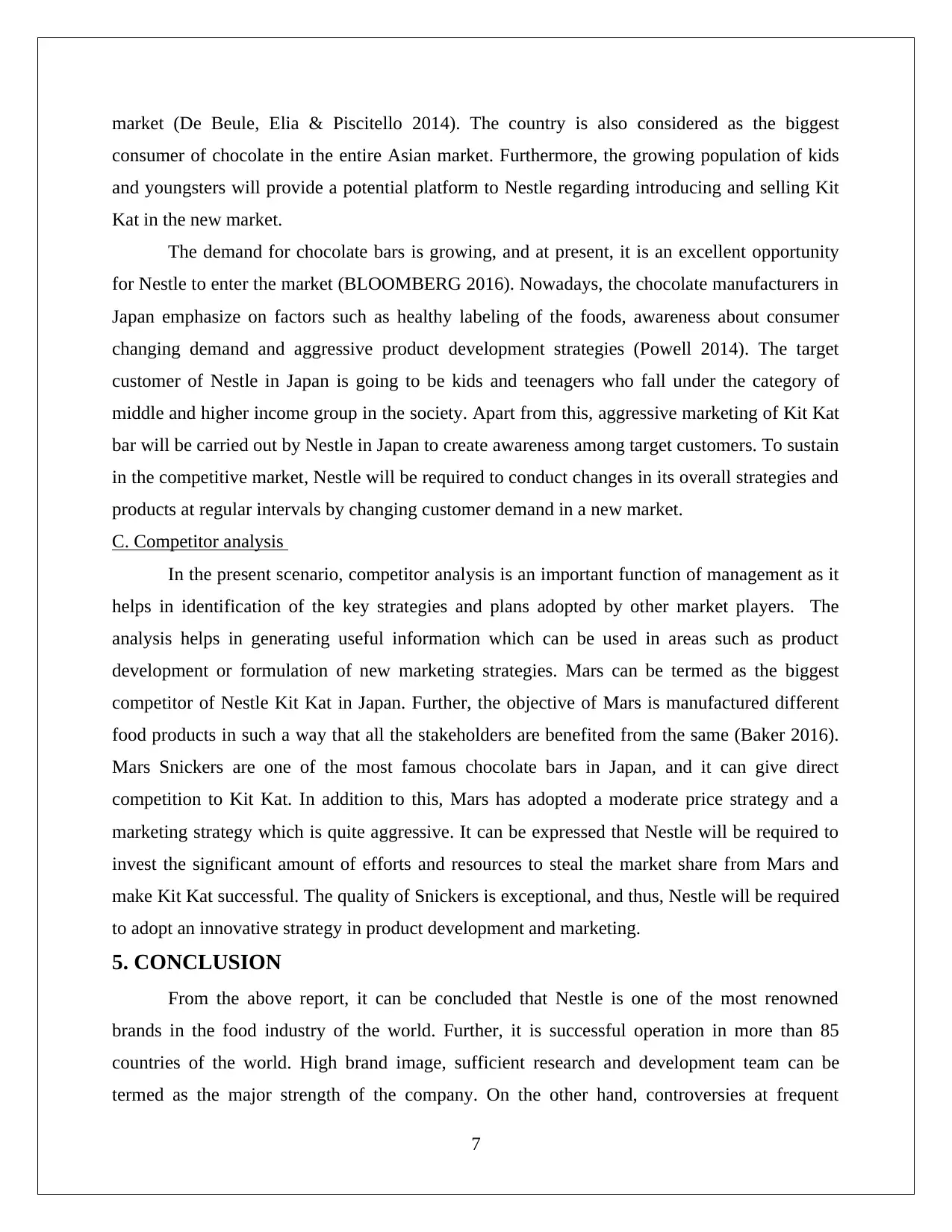
market (De Beule, Elia & Piscitello 2014). The country is also considered as the biggest
consumer of chocolate in the entire Asian market. Furthermore, the growing population of kids
and youngsters will provide a potential platform to Nestle regarding introducing and selling Kit
Kat in the new market.
The demand for chocolate bars is growing, and at present, it is an excellent opportunity
for Nestle to enter the market (BLOOMBERG 2016). Nowadays, the chocolate manufacturers in
Japan emphasize on factors such as healthy labeling of the foods, awareness about consumer
changing demand and aggressive product development strategies (Powell 2014). The target
customer of Nestle in Japan is going to be kids and teenagers who fall under the category of
middle and higher income group in the society. Apart from this, aggressive marketing of Kit Kat
bar will be carried out by Nestle in Japan to create awareness among target customers. To sustain
in the competitive market, Nestle will be required to conduct changes in its overall strategies and
products at regular intervals by changing customer demand in a new market.
C. Competitor analysis
In the present scenario, competitor analysis is an important function of management as it
helps in identification of the key strategies and plans adopted by other market players. The
analysis helps in generating useful information which can be used in areas such as product
development or formulation of new marketing strategies. Mars can be termed as the biggest
competitor of Nestle Kit Kat in Japan. Further, the objective of Mars is manufactured different
food products in such a way that all the stakeholders are benefited from the same (Baker 2016).
Mars Snickers are one of the most famous chocolate bars in Japan, and it can give direct
competition to Kit Kat. In addition to this, Mars has adopted a moderate price strategy and a
marketing strategy which is quite aggressive. It can be expressed that Nestle will be required to
invest the significant amount of efforts and resources to steal the market share from Mars and
make Kit Kat successful. The quality of Snickers is exceptional, and thus, Nestle will be required
to adopt an innovative strategy in product development and marketing.
5. CONCLUSION
From the above report, it can be concluded that Nestle is one of the most renowned
brands in the food industry of the world. Further, it is successful operation in more than 85
countries of the world. High brand image, sufficient research and development team can be
termed as the major strength of the company. On the other hand, controversies at frequent
7
consumer of chocolate in the entire Asian market. Furthermore, the growing population of kids
and youngsters will provide a potential platform to Nestle regarding introducing and selling Kit
Kat in the new market.
The demand for chocolate bars is growing, and at present, it is an excellent opportunity
for Nestle to enter the market (BLOOMBERG 2016). Nowadays, the chocolate manufacturers in
Japan emphasize on factors such as healthy labeling of the foods, awareness about consumer
changing demand and aggressive product development strategies (Powell 2014). The target
customer of Nestle in Japan is going to be kids and teenagers who fall under the category of
middle and higher income group in the society. Apart from this, aggressive marketing of Kit Kat
bar will be carried out by Nestle in Japan to create awareness among target customers. To sustain
in the competitive market, Nestle will be required to conduct changes in its overall strategies and
products at regular intervals by changing customer demand in a new market.
C. Competitor analysis
In the present scenario, competitor analysis is an important function of management as it
helps in identification of the key strategies and plans adopted by other market players. The
analysis helps in generating useful information which can be used in areas such as product
development or formulation of new marketing strategies. Mars can be termed as the biggest
competitor of Nestle Kit Kat in Japan. Further, the objective of Mars is manufactured different
food products in such a way that all the stakeholders are benefited from the same (Baker 2016).
Mars Snickers are one of the most famous chocolate bars in Japan, and it can give direct
competition to Kit Kat. In addition to this, Mars has adopted a moderate price strategy and a
marketing strategy which is quite aggressive. It can be expressed that Nestle will be required to
invest the significant amount of efforts and resources to steal the market share from Mars and
make Kit Kat successful. The quality of Snickers is exceptional, and thus, Nestle will be required
to adopt an innovative strategy in product development and marketing.
5. CONCLUSION
From the above report, it can be concluded that Nestle is one of the most renowned
brands in the food industry of the world. Further, it is successful operation in more than 85
countries of the world. High brand image, sufficient research and development team can be
termed as the major strength of the company. On the other hand, controversies at frequent
7
Paraphrase This Document
Need a fresh take? Get an instant paraphrase of this document with our AI Paraphraser
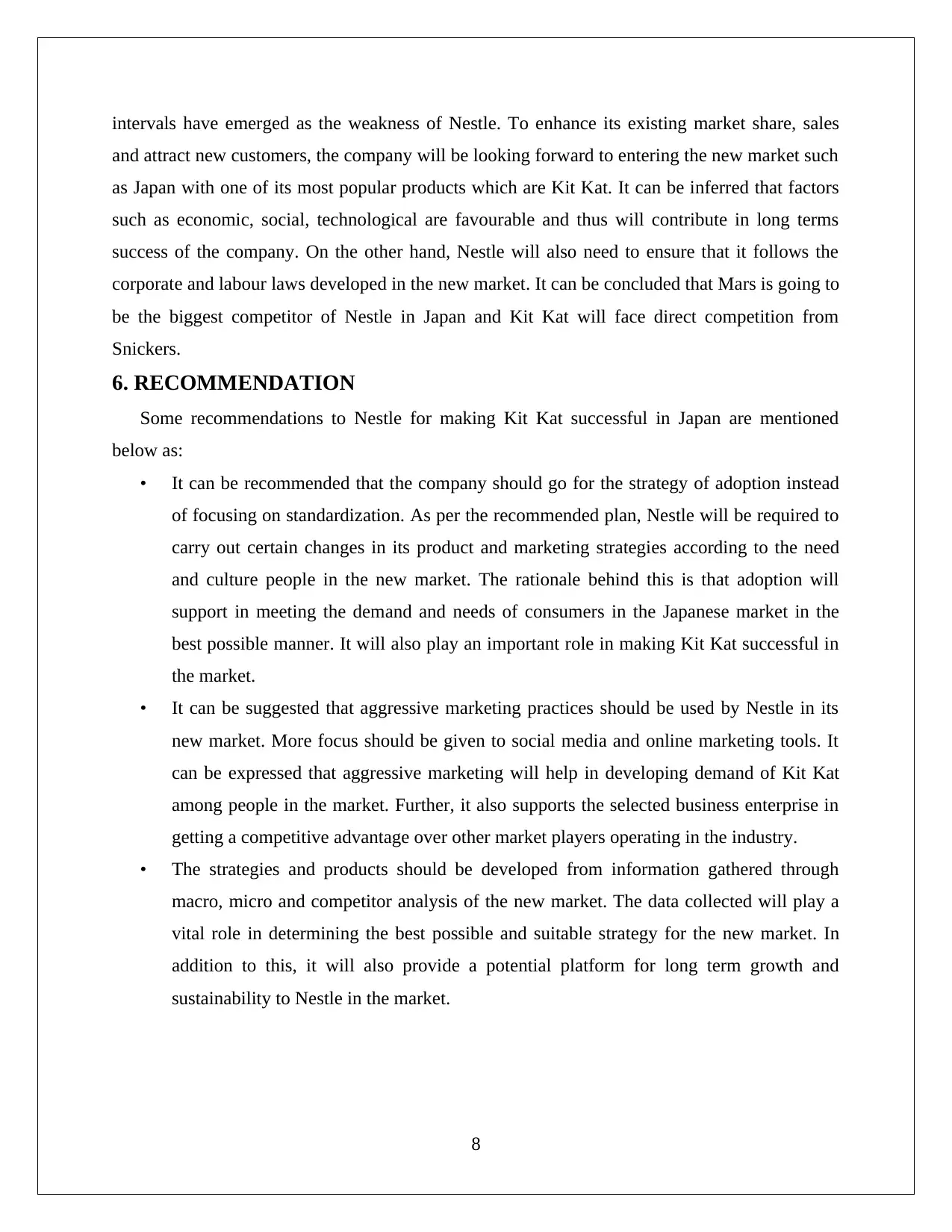
intervals have emerged as the weakness of Nestle. To enhance its existing market share, sales
and attract new customers, the company will be looking forward to entering the new market such
as Japan with one of its most popular products which are Kit Kat. It can be inferred that factors
such as economic, social, technological are favourable and thus will contribute in long terms
success of the company. On the other hand, Nestle will also need to ensure that it follows the
corporate and labour laws developed in the new market. It can be concluded that Mars is going to
be the biggest competitor of Nestle in Japan and Kit Kat will face direct competition from
Snickers.
6. RECOMMENDATION
Some recommendations to Nestle for making Kit Kat successful in Japan are mentioned
below as:
• It can be recommended that the company should go for the strategy of adoption instead
of focusing on standardization. As per the recommended plan, Nestle will be required to
carry out certain changes in its product and marketing strategies according to the need
and culture people in the new market. The rationale behind this is that adoption will
support in meeting the demand and needs of consumers in the Japanese market in the
best possible manner. It will also play an important role in making Kit Kat successful in
the market.
• It can be suggested that aggressive marketing practices should be used by Nestle in its
new market. More focus should be given to social media and online marketing tools. It
can be expressed that aggressive marketing will help in developing demand of Kit Kat
among people in the market. Further, it also supports the selected business enterprise in
getting a competitive advantage over other market players operating in the industry.
• The strategies and products should be developed from information gathered through
macro, micro and competitor analysis of the new market. The data collected will play a
vital role in determining the best possible and suitable strategy for the new market. In
addition to this, it will also provide a potential platform for long term growth and
sustainability to Nestle in the market.
8
and attract new customers, the company will be looking forward to entering the new market such
as Japan with one of its most popular products which are Kit Kat. It can be inferred that factors
such as economic, social, technological are favourable and thus will contribute in long terms
success of the company. On the other hand, Nestle will also need to ensure that it follows the
corporate and labour laws developed in the new market. It can be concluded that Mars is going to
be the biggest competitor of Nestle in Japan and Kit Kat will face direct competition from
Snickers.
6. RECOMMENDATION
Some recommendations to Nestle for making Kit Kat successful in Japan are mentioned
below as:
• It can be recommended that the company should go for the strategy of adoption instead
of focusing on standardization. As per the recommended plan, Nestle will be required to
carry out certain changes in its product and marketing strategies according to the need
and culture people in the new market. The rationale behind this is that adoption will
support in meeting the demand and needs of consumers in the Japanese market in the
best possible manner. It will also play an important role in making Kit Kat successful in
the market.
• It can be suggested that aggressive marketing practices should be used by Nestle in its
new market. More focus should be given to social media and online marketing tools. It
can be expressed that aggressive marketing will help in developing demand of Kit Kat
among people in the market. Further, it also supports the selected business enterprise in
getting a competitive advantage over other market players operating in the industry.
• The strategies and products should be developed from information gathered through
macro, micro and competitor analysis of the new market. The data collected will play a
vital role in determining the best possible and suitable strategy for the new market. In
addition to this, it will also provide a potential platform for long term growth and
sustainability to Nestle in the market.
8
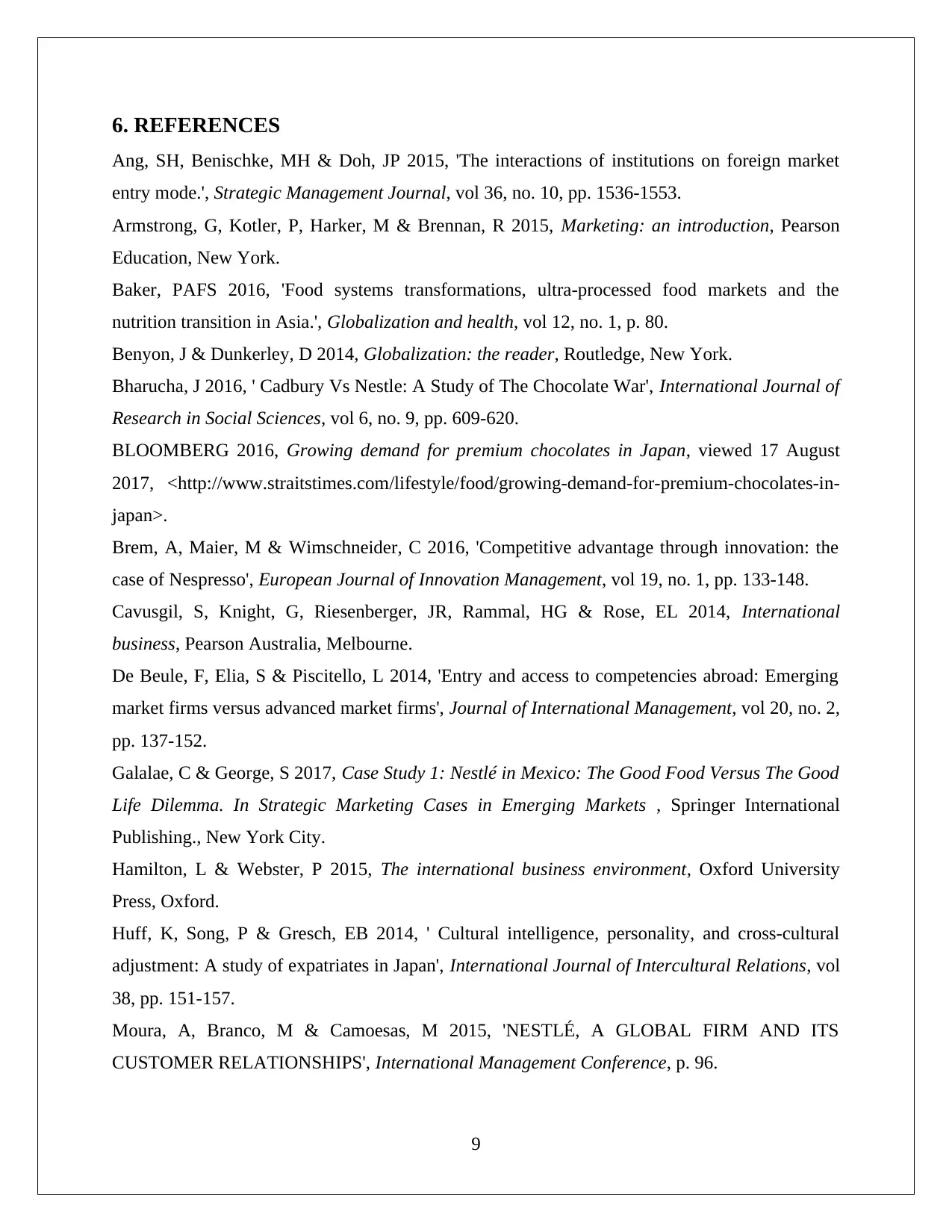
6. REFERENCES
Ang, SH, Benischke, MH & Doh, JP 2015, 'The interactions of institutions on foreign market
entry mode.', Strategic Management Journal, vol 36, no. 10, pp. 1536-1553.
Armstrong, G, Kotler, P, Harker, M & Brennan, R 2015, Marketing: an introduction, Pearson
Education, New York.
Baker, PAFS 2016, 'Food systems transformations, ultra-processed food markets and the
nutrition transition in Asia.', Globalization and health, vol 12, no. 1, p. 80.
Benyon, J & Dunkerley, D 2014, Globalization: the reader, Routledge, New York.
Bharucha, J 2016, ' Cadbury Vs Nestle: A Study of The Chocolate War', International Journal of
Research in Social Sciences, vol 6, no. 9, pp. 609-620.
BLOOMBERG 2016, Growing demand for premium chocolates in Japan, viewed 17 August
2017, <http://www.straitstimes.com/lifestyle/food/growing-demand-for-premium-chocolates-in-
japan>.
Brem, A, Maier, M & Wimschneider, C 2016, 'Competitive advantage through innovation: the
case of Nespresso', European Journal of Innovation Management, vol 19, no. 1, pp. 133-148.
Cavusgil, S, Knight, G, Riesenberger, JR, Rammal, HG & Rose, EL 2014, International
business, Pearson Australia, Melbourne.
De Beule, F, Elia, S & Piscitello, L 2014, 'Entry and access to competencies abroad: Emerging
market firms versus advanced market firms', Journal of International Management, vol 20, no. 2,
pp. 137-152.
Galalae, C & George, S 2017, Case Study 1: Nestlé in Mexico: The Good Food Versus The Good
Life Dilemma. In Strategic Marketing Cases in Emerging Markets , Springer International
Publishing., New York City.
Hamilton, L & Webster, P 2015, The international business environment, Oxford University
Press, Oxford.
Huff, K, Song, P & Gresch, EB 2014, ' Cultural intelligence, personality, and cross-cultural
adjustment: A study of expatriates in Japan', International Journal of Intercultural Relations, vol
38, pp. 151-157.
Moura, A, Branco, M & Camoesas, M 2015, 'NESTLÉ, A GLOBAL FIRM AND ITS
CUSTOMER RELATIONSHIPS', International Management Conference, p. 96.
9
Ang, SH, Benischke, MH & Doh, JP 2015, 'The interactions of institutions on foreign market
entry mode.', Strategic Management Journal, vol 36, no. 10, pp. 1536-1553.
Armstrong, G, Kotler, P, Harker, M & Brennan, R 2015, Marketing: an introduction, Pearson
Education, New York.
Baker, PAFS 2016, 'Food systems transformations, ultra-processed food markets and the
nutrition transition in Asia.', Globalization and health, vol 12, no. 1, p. 80.
Benyon, J & Dunkerley, D 2014, Globalization: the reader, Routledge, New York.
Bharucha, J 2016, ' Cadbury Vs Nestle: A Study of The Chocolate War', International Journal of
Research in Social Sciences, vol 6, no. 9, pp. 609-620.
BLOOMBERG 2016, Growing demand for premium chocolates in Japan, viewed 17 August
2017, <http://www.straitstimes.com/lifestyle/food/growing-demand-for-premium-chocolates-in-
japan>.
Brem, A, Maier, M & Wimschneider, C 2016, 'Competitive advantage through innovation: the
case of Nespresso', European Journal of Innovation Management, vol 19, no. 1, pp. 133-148.
Cavusgil, S, Knight, G, Riesenberger, JR, Rammal, HG & Rose, EL 2014, International
business, Pearson Australia, Melbourne.
De Beule, F, Elia, S & Piscitello, L 2014, 'Entry and access to competencies abroad: Emerging
market firms versus advanced market firms', Journal of International Management, vol 20, no. 2,
pp. 137-152.
Galalae, C & George, S 2017, Case Study 1: Nestlé in Mexico: The Good Food Versus The Good
Life Dilemma. In Strategic Marketing Cases in Emerging Markets , Springer International
Publishing., New York City.
Hamilton, L & Webster, P 2015, The international business environment, Oxford University
Press, Oxford.
Huff, K, Song, P & Gresch, EB 2014, ' Cultural intelligence, personality, and cross-cultural
adjustment: A study of expatriates in Japan', International Journal of Intercultural Relations, vol
38, pp. 151-157.
Moura, A, Branco, M & Camoesas, M 2015, 'NESTLÉ, A GLOBAL FIRM AND ITS
CUSTOMER RELATIONSHIPS', International Management Conference, p. 96.
9
⊘ This is a preview!⊘
Do you want full access?
Subscribe today to unlock all pages.

Trusted by 1+ million students worldwide
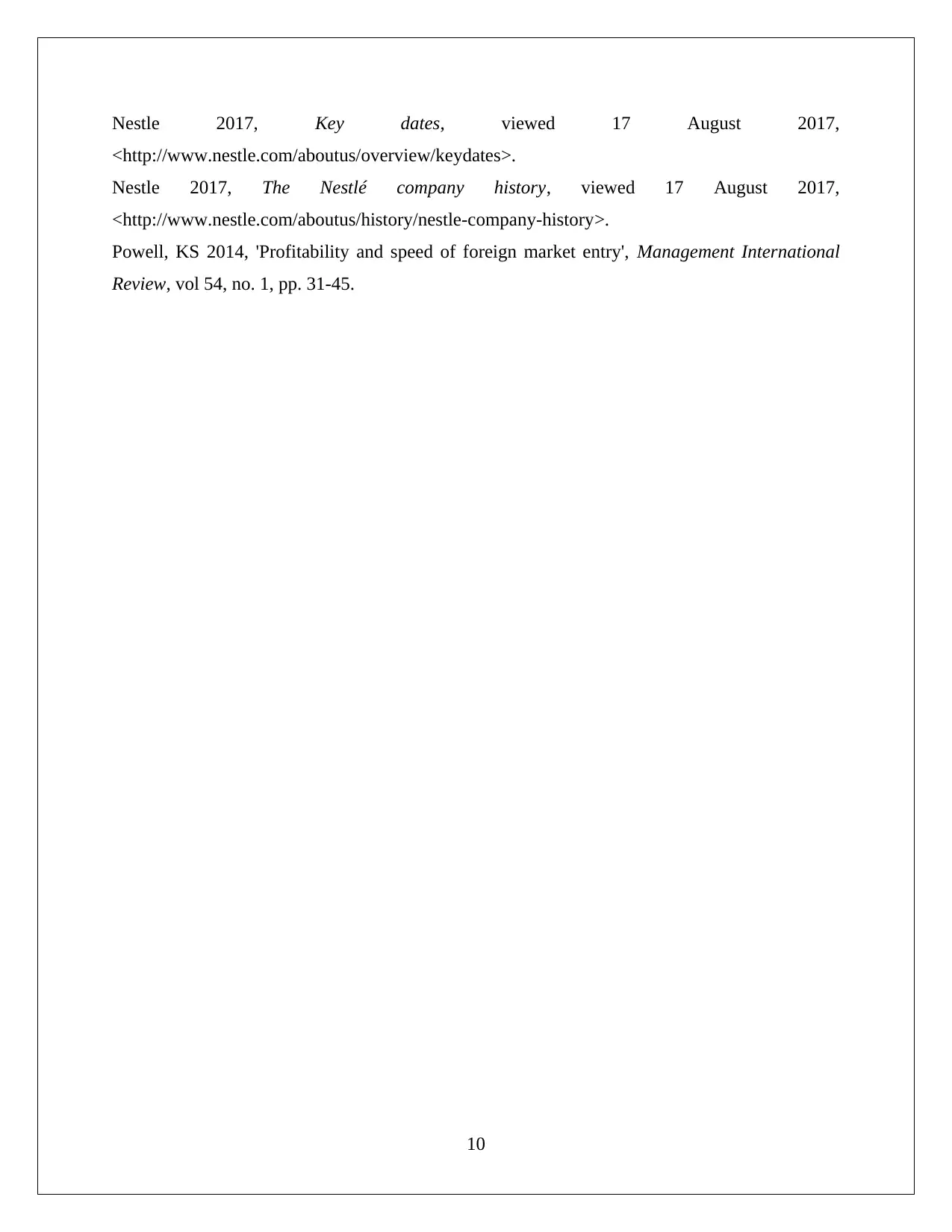
Nestle 2017, Key dates, viewed 17 August 2017,
<http://www.nestle.com/aboutus/overview/keydates>.
Nestle 2017, The Nestlé company history, viewed 17 August 2017,
<http://www.nestle.com/aboutus/history/nestle-company-history>.
Powell, KS 2014, 'Profitability and speed of foreign market entry', Management International
Review, vol 54, no. 1, pp. 31-45.
10
<http://www.nestle.com/aboutus/overview/keydates>.
Nestle 2017, The Nestlé company history, viewed 17 August 2017,
<http://www.nestle.com/aboutus/history/nestle-company-history>.
Powell, KS 2014, 'Profitability and speed of foreign market entry', Management International
Review, vol 54, no. 1, pp. 31-45.
10
1 out of 10
Related Documents
Your All-in-One AI-Powered Toolkit for Academic Success.
+13062052269
info@desklib.com
Available 24*7 on WhatsApp / Email
![[object Object]](/_next/static/media/star-bottom.7253800d.svg)
Unlock your academic potential
Copyright © 2020–2025 A2Z Services. All Rights Reserved. Developed and managed by ZUCOL.





